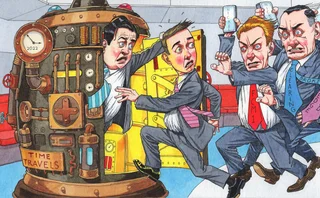
Nickel debacle weakens UK’s case on clearing supervision
LME episode comes amid scrutiny of UK regime and fresh Brexit row
Just over a decade ago, London and its exchanges found themselves suddenly popular. Spurred on by a weaker pound, strong derivatives markets and the UK’s position as a corporate-friendly beachhead within the EU, a raft of foreign suitors queued up to buy its bourses, with none more in demand than the London Metal Exchange.
Today, the still weaker pound aside, things feel a little different.
The LME’s decision to cancel some $4 billion worth of nickel trades in early March was historic for less popular reasons. Ten days after Russia’s invasion of Ukraine, prices skyrocketed 250% inside 24 hours, leading the bourse to declare a “disorderly” market – a move that has attracted vitriol and lawsuits from the hedge funds on the winning side of those trades.
The LME’s position has remained steadfast: it acted to protect its members. Chief executive Matt Chamberlain’s own words of mitigation were blunt: the exchange felt it couldn’t call the short side of those trades without causing a chain of defaults. That may have been enough to convince LME Clear’s management – and its regulators – that it had no choice but to jump through several stages of the central counterparty’s rule book, and permit a near-unprecedented tear-up.
If that’s the case, it remains extraordinary; risk veterans quietly point out most CCPs have this option in their rule book, but none have exercised it in modern financial markets. If anything, it’s still harder to fathom why, as Risk.net first reported, margins on a metal significantly disrupted by Russia’s invasion had scarcely budged 10 days into the war. Or indeed why the bourse felt it lacked sufficient information on sizeable end-users’ aggregate positions, and perhaps most damningly of all, why it had failed to introduce circuit breakers on key contracts in the advent, despite members’ chuntering.
In laying bare the decision-making that led it to this point, exonerating factors could still come to light. But members may not wait to find out: some, including base metals player Britannia Financial, have already voted with their feet. How many follow them might depend on what emerges from one of two reports, from UK regulators and the LME’s independent report into what happened – a job Chamberlain indicated it was still tendering for last week – or via court proceedings.
Either report could have serious implications for the LME’s supervisors too. At a tricky moment for post-Brexit EU relations, the UK is trying to make the case for the right to carry on supervising its own CCPs. It is also less than two years since LME Clear was the only CCP to fail Esma’s stress tests, blowing through its stated default resources off the back of simulated metals market moves the bourse said it considered unrealistic.
CME Group and Ice, of course, had designs on buying the LME before Hong Kong Exchanges and Clearing ultimately bought it in 2012. While one of the two exchange giants has been content to throw stones, the other is getting down to business, and is already talking to LME’s customers: CME has plans to launch a nickel contract by the end of the year, market sources have indicated.
In a very different context, the US derivatives markets’ chief regulator noted recently that his watchdog has a Congressional mandate to ensure the primacy of US markets; at the moment, London’s markets and its supervisors are doing their job for them.
Additional reporting by Costas Mourselas
Only users who have a paid subscription or are part of a corporate subscription are able to print or copy content.
To access these options, along with all other subscription benefits, please contact info@risk.net or view our subscription options here: http://subscriptions.risk.net/subscribe
You are currently unable to print this content. Please contact info@risk.net to find out more.
You are currently unable to copy this content. Please contact info@risk.net to find out more.
Copyright Infopro Digital Limited. All rights reserved.
As outlined in our terms and conditions, https://www.infopro-digital.com/terms-and-conditions/subscriptions/ (point 2.4), printing is limited to a single copy.
If you would like to purchase additional rights please email info@risk.net
Copyright Infopro Digital Limited. All rights reserved.
You may share this content using our article tools. As outlined in our terms and conditions, https://www.infopro-digital.com/terms-and-conditions/subscriptions/ (clause 2.4), an Authorised User may only make one copy of the materials for their own personal use. You must also comply with the restrictions in clause 2.5.
If you would like to purchase additional rights please email info@risk.net
More on Our take
Podcast: Alexandre Antonov turns down the noise in Markowitz
Adia quant explains how to apply hierarchical risk parity to a minimum-variance portfolio
Why did UK keep the pension fund clearing exemption?
Liquidity concerns, desire for higher returns and clearing capacity all possible reasons for going its own way
UBS’s Iabichino holds a mirror to bank funding risks
Framing funding management as an optimal control problem affords an alternative to proxy hedging
Trump 2.0 bank supervision: simpler but no soft touch?
Republican FDIC vice-chair Travis Hill wants more focus on financial risk instead of process
Lots to fear, including fear itself
Binary scenarios for key investment risks in this year’s Top 10 are worrying buy-siders
Podcast: Alexei Kondratyev on quantum computing
Imperial College London professor updates expectations for future tech
Quants mine gold for new market-making model
Novel approach to modelling cointegrated assets could be applied to FX and potentially even corporate bond pricing
Thin-skinned: are CCPs skimping on capital cover?
Growth of default funds calls into question clearers’ skin in the game









